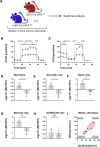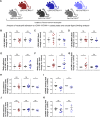Neutrophil-specific expression of JAK2-V617F or CALRmut induces distinct inflammatory profiles in myeloproliferative neoplasia
- PMID: 38853260
- PMCID: PMC11163796
- DOI: 10.1186/s13045-024-01562-5
Neutrophil-specific expression of JAK2-V617F or CALRmut induces distinct inflammatory profiles in myeloproliferative neoplasia
Abstract
Background: Neutrophils play a crucial role in inflammation and in the increased thrombotic risk in myeloproliferative neoplasms (MPNs). We have investigated how neutrophil-specific expression of JAK2-V617F or CALRdel re-programs the functions of neutrophils.
Methods: Ly6G-Cre JAK2-V617F and Ly6G-Cre CALRdel mice were generated. MPN parameters as blood counts, splenomegaly and bone marrow histology were compared to wild-type mice. Megakaryocyte differentiation was investigated using lineage-negative bone marrow cells upon in vitro incubation with TPO/IL-1β. Cytokine concentrations in serum of mice were determined by Mouse Cytokine Array. IL-1α expression in various hematopoietic cell populations was determined by intracellular FACS analysis. RNA-seq to analyse gene expression of inflammatory cytokines was performed in isolated neutrophils from JAK2-V617F and CALR-mutated mice and patients. Bioenergetics of neutrophils were recorded on a Seahorse extracellular flux analyzer. Cell motility of neutrophils was monitored in vitro (time lapse microscopy), and in vivo (two-photon microscopy) upon creating an inflammatory environment. Cell adhesion to integrins, E-selectin and P-selection was investigated in-vitro. Statistical analysis was carried out using GraphPad Prism. Data are shown as mean ± SEM. Unpaired, two-tailed t-tests were applied.
Results: Strikingly, neutrophil-specific expression of JAK2-V617F, but not CALRdel, was sufficient to induce pro-inflammatory cytokines including IL-1 in serum of mice. RNA-seq analysis in neutrophils from JAK2-V617F mice and patients revealed a distinct inflammatory chemokine signature which was not expressed in CALR-mutant neutrophils. In addition, IL-1 response genes were significantly enriched in neutrophils of JAK2-V617F patients as compared to CALR-mutant patients. Thus, JAK2-V617F positive neutrophils, but not CALR-mutant neutrophils, are pathogenic drivers of inflammation in MPN. In line with this, expression of JAK2-V617F or CALRdel elicited a significant difference in the metabolic phenotype of neutrophils, suggesting a stronger inflammatory activity of JAK2-V617F cells. Furthermore, JAK2-V617F, but not CALRdel, induced a VLA4 integrin-mediated adhesive phenotype in neutrophils. This resulted in reduced neutrophil migration in vitro and in an inflamed vessel. This mechanism may contribute to the increased thrombotic risk of JAK2-V617F patients compared to CALR-mutant individuals.
Conclusions: Taken together, our findings highlight genotype-specific differences in MPN-neutrophils that have implications for the differential pathophysiology of JAK2-V617F versus CALR-mutant disease.
Keywords: CALR mutations; Inflammation; JAK2-V617F; MPN; Neutrophils.
© 2024. The Author(s).
Conflict of interest statement
D.B.L. works as a drug safety physician for Infectopharm. All other authors declare no conflict of interest.
Figures









Similar articles
-
Activation of integrin signaling up-regulates pro-inflammatory cytokines in JAK2-V617F positive hematopoietic cells.Cell Commun Signal. 2025 Aug 11;23(1):368. doi: 10.1186/s12964-025-02358-x. Cell Commun Signal. 2025. PMID: 40790213 Free PMC article.
-
Differential modulation of mutant CALR and JAK2 V617F-driven oncogenesis by HLA genotype in myeloproliferative neoplasms.Front Immunol. 2024 Sep 16;15:1427810. doi: 10.3389/fimmu.2024.1427810. eCollection 2024. Front Immunol. 2024. PMID: 39351227 Free PMC article.
-
Activating mutations in JAK2 and CALR differentially affect intracellular calcium flux in store operated calcium entry.Cell Commun Signal. 2024 Mar 21;22(1):186. doi: 10.1186/s12964-024-01530-z. Cell Commun Signal. 2024. PMID: 38509561 Free PMC article.
-
Changing concepts of diagnostic criteria of myeloproliferative disorders and the molecular etiology and classification of myeloproliferative neoplasms: from Dameshek 1950 to Vainchenker 2005 and beyond.Acta Haematol. 2015;133(1):36-51. doi: 10.1159/000358580. Epub 2014 Aug 7. Acta Haematol. 2015. PMID: 25116092 Review.
-
Mechanism underlying the development of myeloproliferative neoplasms through mutant calreticulin.Cancer Sci. 2020 Aug;111(8):2682-2688. doi: 10.1111/cas.14503. Epub 2020 Jun 27. Cancer Sci. 2020. PMID: 32462673 Free PMC article. Review.
Cited by
-
Research trends in essential thrombocythemia from 2001 to 2024: a bibliometric analysis.Discov Oncol. 2025 Apr 15;16(1):528. doi: 10.1007/s12672-025-02232-9. Discov Oncol. 2025. PMID: 40232559 Free PMC article.
References
Publication types
MeSH terms
Substances
Grants and funding
LinkOut - more resources
Full Text Sources
Molecular Biology Databases
Research Materials
Miscellaneous

